This article was posted by CrystalWind.ca.
Forbidden City- Beijing China
- Details
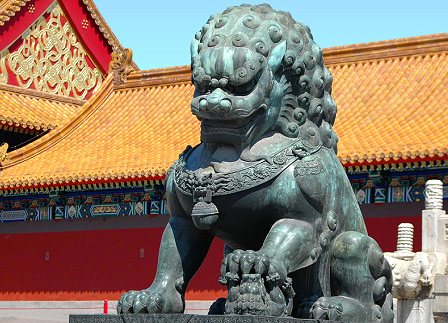 At the beginning of the fifteenth century, the third Ming emperor, YongLe, created one of the most dazzling architectural masterpieces in the world.
At the beginning of the fifteenth century, the third Ming emperor, YongLe, created one of the most dazzling architectural masterpieces in the world.
The Forbidden City, located in the center of China's capital, Beijing, displays an extraordinarily harmonious balance between buildings and open space within a more or less symmetrical layout.
His three architects, Hsu Tai, Yuan An and Feng Chiao, were given the brief to build an extravagant set of palaces to serve as the emperor's metropolis. Audience halls were needed for receiving delegations, together with temples for ritual purification and processional paths. Also required were large domestic quarters with gardens for himself and his family as well as administrative accommodation, a shrine for ancestral rites and, as patron of three types of religion, temples of Buddhism, Lamaism and Taoism.
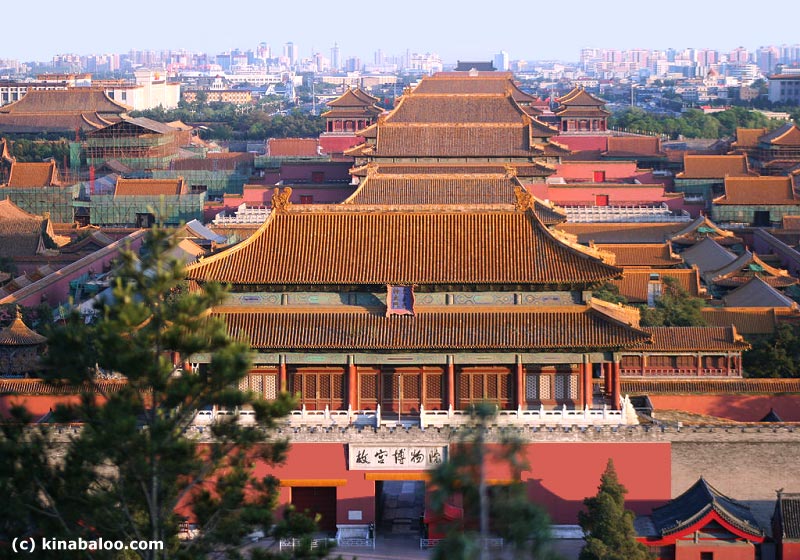
The Purple Forbidden City
From the start, the Forbidden City was enmeshed in ritualistic and religious concepts. Legend has it that the very structure of the Forbidden City was conceived in a dream by YongLe's tutor, a visionary monk.
The monk imagined an extraterrestrial city, where the Lord of Heaven resided in a purple enclosure (believed to be a constellation formed by 15 heavenly bodies turning round the polestar). According to Chinese cosmology, the colour purple was a symbol of joy and happiness and also that of the polestar. In this way, the emperor established himself as the Son of Heaven, with the mandate to maintain harmony between the human and natural world, balancing the vastness of nature with a uniform modular system of rectangular courtyards and buildings. He and his city became linked to the divine forces of the universe. Therefore, the residence of the emperor was a purple city at the center of the temporal world.
Only the emperor could use the color purple, the color of the walls, and of the special vermilion ink with which the emperor signed his name.
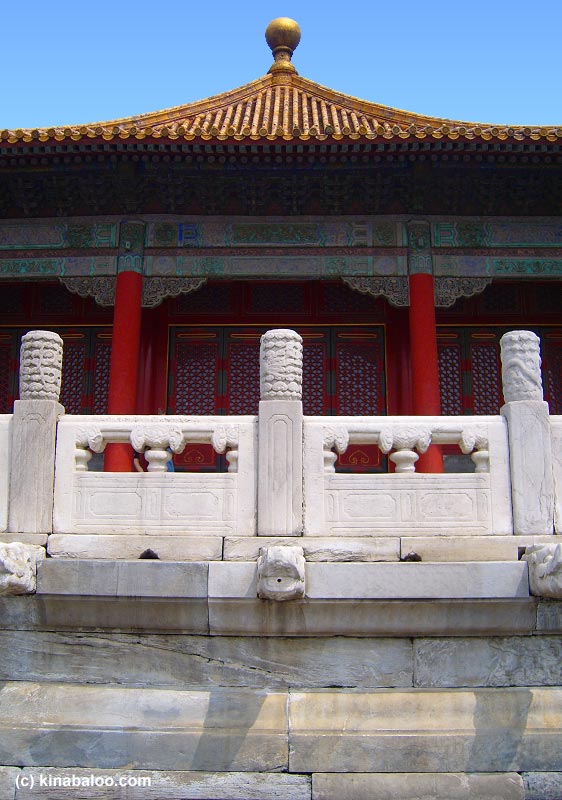
YongLe's home became known as 'Zi Jin Ch'eng'. This has the meaning : 'the purple city (Ch'eng) of the polestar (Tzu), where one cannot enter (jin)'. The literal meaning of China (ChungHua) is 'the country at the centre' or 'middle kingdom', leading to the idea that the Forbidden City is at the very centre of the world.
The Forbidden City was constructed in accordance with ancient rules of spatial design, first used during the Han dynasty in building the city of Chang'An (modern XiAn), between 206 BC and AD 220. Among other things, these rules specified that the principal buildings should be aligned along a straight axis from south to north, flanked by a symmetrical arrangement of minor structures on parallel axes. This architectural convention was favourable to YungLo's claim that his city had symbolic importance. He believed that a centralized configuration of buildings would also serve as a reflection of the ordered heavens.
The chilling north was regarded as a harmful direction. Because all invasions of China had originated from the north, it came to represent evil spirits, cold winds and the wicked warriors from the Steppes. Hence, nearly all the buildings in the Forbidden City face south, the direction of holiness, giving protection from icy winds and also permitting subtle decoration based on catching infinite variations of sunlight. In fact, the only pavilions facing north were for the emperor's rejected concubines.
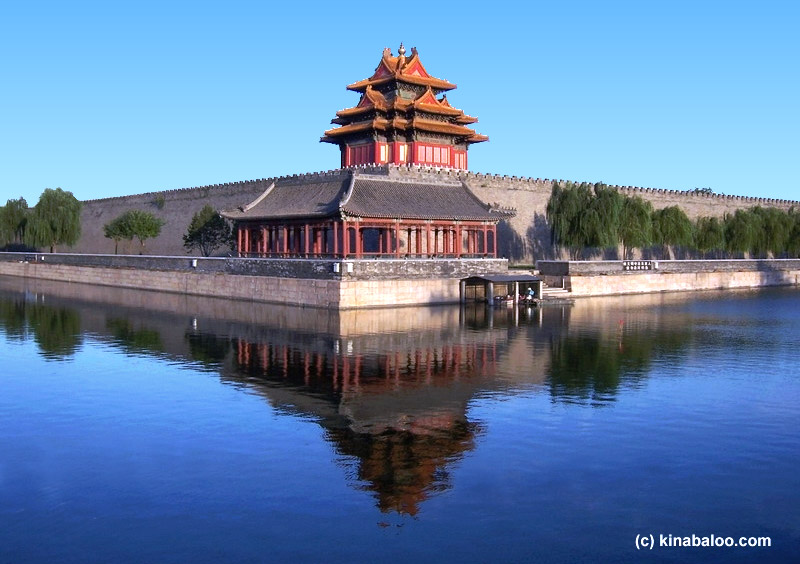
The enclosing wall (being synonymous with the word for 'city' in China) was a major component in city planning, with huge towers over the gates and watchtowers at the four corners.
In part, the Chinese philosophy of Taoism seeks harmony with nature. The mysterious art of Feng-Shui (literally, 'wind-water') was used to help harmonize buildings with natural forces. The Chinese architectural tradition for placing major buildings along an axis also allowed asymmetrical elements to be introduced, such as the natural release of trees, lakes and canals.
All of the five elemental colors (as specified by Chinese philosophers) were introduced in the design of the city : white marble terraces, (almost) black paving of the courtyards, red columns, with yellow roofs, all on a sky blue background as reflected in the moat. The majesty of this purple walled city with its golden yellow rooftops standing tall among all the uniformly grey and far smaller hutongs must have been an extraordinary sight. The high, vermilion palace walls, by keeping the emperor hidden, enhanced his mystique and glory.
Construction of the Forbidden City started in 1406, the 5th year of YongLo's reign. The construction took 14 years - and an estimated one million workers, and 100,000 artisans, were involved.
Stones needed were quarried from FangShan, a suburb of Beijing. It is said that a well was dug every 50 meters in order to pour water onto the road in winter to slide the huge stones along ice into the city. In the summer, logs were used to roll the rocks along.
Huge amounts of timbers and other materials were also freighted in, many from faraway provinces.
From its completion in 1420 to 1644, when a peasant revolt invaded it, the Forbidden City served as the seat of the Ming Dynasty. The following Qing Dynasty also resided in the Forbidden City. By the end of the eighteenth century, some 9000 people were estimated to reside there.
After being the home of 24 emperors - fourteen of the Ming dynasty and the ten of the Qing - the Forbidden City ceased being the political center of China in 1912 with the abdication of Pu Yi, the last Emperor of China. He was, however, allowed (in fact, required) to live within the walls of the Forbidden City, until a coup launched by a local general (Feng YuXiang) in 1924 expelled him.
Having been the imperial palace for some five centuries, it houses numerous rare treasures and curiosities. In 1947, after they had been moved from one location to another inside mainland China for many years (most recently to be hidden from the Japanese in the Sino-Japanese war), Chiang Kai-Shek ordered many of the artifacts within the Forbidden City to be moved to Taiwan where they later formed the core of the National Palace Museum in Taipei.
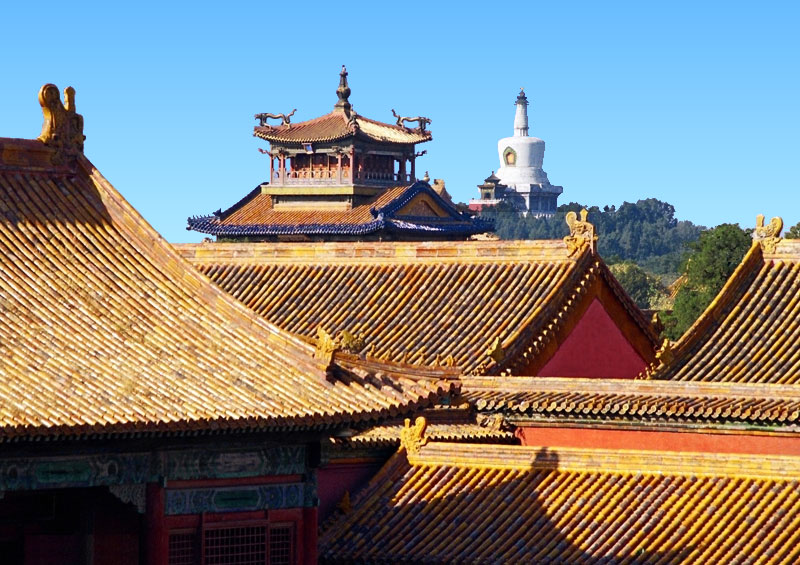
Just a few of the many golden yellow rooftops, with the White Dagoba in Beihai Park visible in the distance.
This action has been extremely controversial, with some regarding it as looting with others regarding it as safekeeping, especially given the events of the Cultural Revolution on the mainland. However, many treasures (about 1 million) are now housed within the Forbidden City - and many of these are on display to visitors, including gifts of state, military campaign treasures, and the furnishings and possessions of members of the imperial household. Many others (about 650,000 objects) remain in the National Museum in Taipei, Taiwan.
If we look at a map of Beijing from around 1600, we can see it is quite familiar in many ways. Some of the roads familiar today existed then - such as the shopping streets of WanFuJing and XiDan. We can also see that the subway loop line (line 2) follows the path of the old city wall and that the second ring road follows it too - following the extended city wall to the south. The old city walls are shown in red.
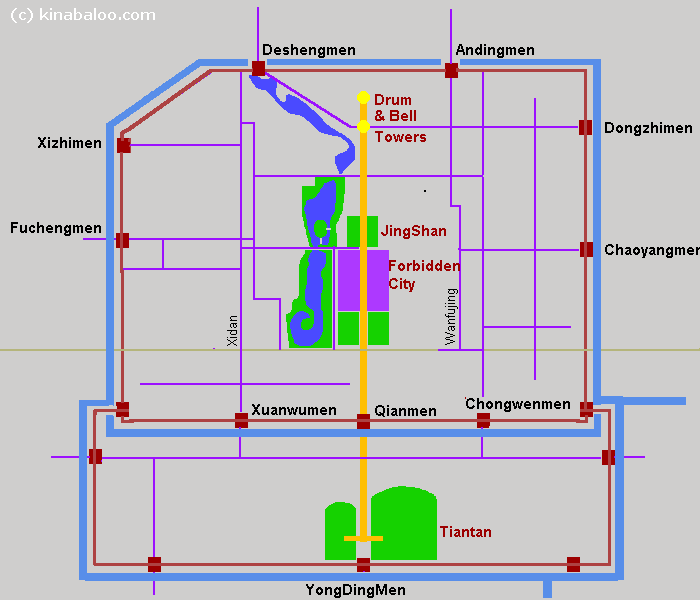
A part of the old city wall can be seen at ChongWenMen ('men' means gate in Chinese). An old gate still exists at DeShengMen. Parts of the moat / canal also still exist, at least in location, including most of the canal that could transport the emperor to the Summer Palace (YiHeYuan).
An important thing to note is the importance of the north-south axis in the imperial city, extending from the drum and bell towers in the north to the Temple of Heaven in the south. Today, the primary axis is east - west with the creation of the grand boulevard ChangAn. On the map, the location of ChangAn is shown in pale grey/green; it hardly existed in the days of the Ming Dynasty.
In the southern part of the outer city is the Temple of Heaven (TianTan). To the north of the inner city is Ditan (terrace), to the east Ritan and west Yuetan, forming the four peripheral key points, clustered around the imperial city. The Imperial Ancestral Temple (TaiMiao) and the altar for worshipping the god of the land and the god of grain (SheJiTan) were located on the left and right sides in front of Wumen, the front gate of the Forbidden City (now called ZhongShan Park and the Working People's Cultural park respectively).
On the annual Winter Solstice (22nd solar term), the Summer Solstice (10th solar term), the Spring Equinox (4th solar term), and Autumnal Equinox (16th solar term), the emperor went to TianTan, DiTan, RiTan and YueTan respectively to perform sacrificial rites. The correspondence of TianTan, DiTan, RiTan and YueTan to winter, summer, spring and autumn, and also to south, north, east and west, demonstrated the ancient Chinese world outlook on the integration of man and heaven.
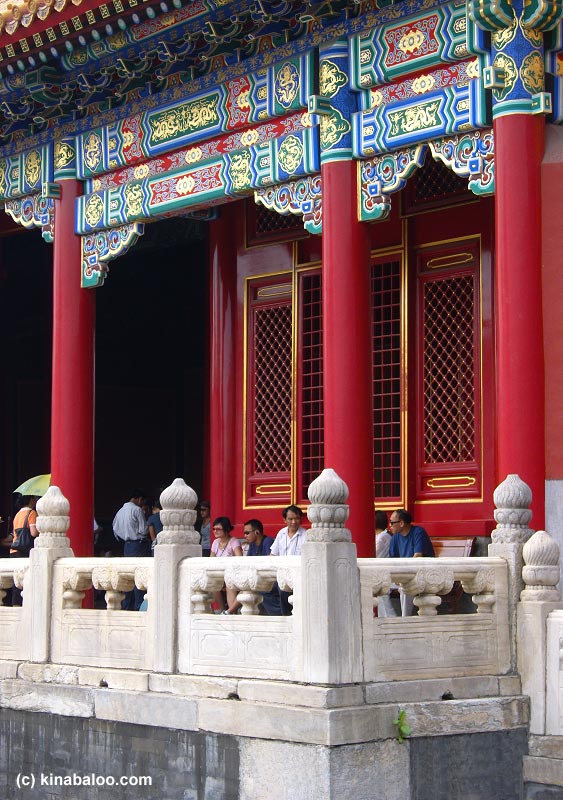
Videos of the Hidden City
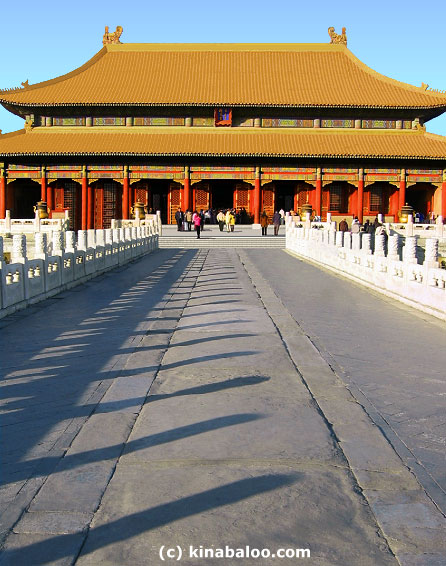
In the early 1400s, the third Ming Emperor, YongLe, moved the capital of China to Beijing. In 1406, he began construction of a new 'Forbidden City' that would include an imperial palace complex of vast proportions - a grand design.
Located at the exact center of the ancient city of Beijing, the palace was the home and center of power for 24 emperors during the mid to later Ming and Qing dynasties.
Now officially renamed as the 'Palace Museum' ('GuGong' in Chinese, meaning simply 'Old Palace'), the extensive grounds cover over 700,000 square meters. There are around 800 buildings that have about 9,000 rooms in total. The Forbidden City is the world's largest palace complex. Indeed, it is listed by UNESCO as the world's largest collection of preserved ancient wood-based structures and was declared a World Heritage Site in 1987.
Although the foundations are stone and the walls made of brick, the buildings themselves are constructed almost entirely of wood. The skills for this are quite amazing, but there is the problem of fire, especially with candlelight and incense burning. That's why there are many large vats all around the palace, to store water for any outbreak of fire. The vats are raised on stone feet so that a fire could be lit underneath to stop the water freezing during harsh winter weather.
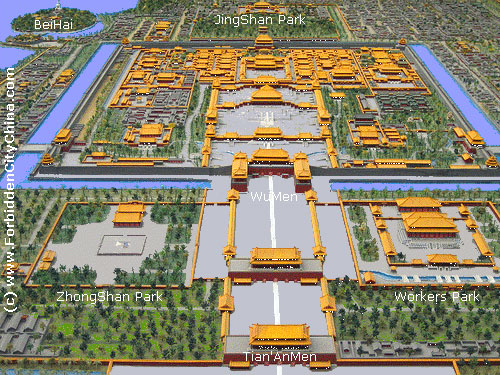
The Forbidden City is encircled by a 50 meter wide moat then a 10 meter high purple wall; the perimeter is almost 3.5 kilometers long and the enclosed area about twice the size of Tian'AnMen Square. It lies at the center of YongLe's reconstructed Beijing, and symbolically between the Temple of Heaven (TianTan) to the south, and the Temple of Earth (DiTan) to the north along a central axis 8 kilometers in length. It was to be a reflection of heavenly order and a symbol of the emperor's heavenly mandate. At the heart of the walled city, and also a walled inner city, the palace was a city within a city.
The Forbidden City is located directly to the north of Tian'AnMen Square and can be accessed from the square via Tian'AnMen Gate. This takes you through the grand and enveloping south gate of the palace (WuMen), the 'front door'.
The Forbidden City remains a national symbol and an image of its entrance gate is part of the official seal of the People's Republic of China.
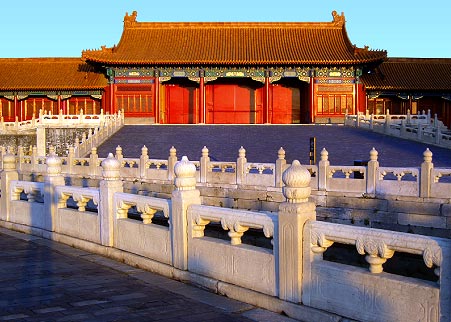
The last emperor of China, PuYi, ascended the throne aged 3, but just four years earlier the republican movement brought an end to imperial era in 1912. PuYi was forced to stay in the palace during the following twelve years but was evicted in 1924, and in 1925 ordinary folk entered the palace for the first time.
YongLe was the third emperor of the Ming Dynasty (Han Chinese, 1368 - 1644). He restored BeiJing ('north capital') as the official capital, as it had previously been set by Kublai Khan of the previous Yuan Dynasty (Mongolian, 1271 - 1368) when it was known as Dadu ('great capital'). YongLe put in place not just the Forbidden City but the basic layout and main features of the historical Beijing that we see today. He also renovated and restored use of the Grand Canal to bring goods from South China to the capital. He also supported the grand sea voyages of ZhengHe.
YongLe died just four years after the palace was completed. The later Ming Dynasty is associated with the building of a new, stone and brick Great Wall, the one on whose ruins we walk today.
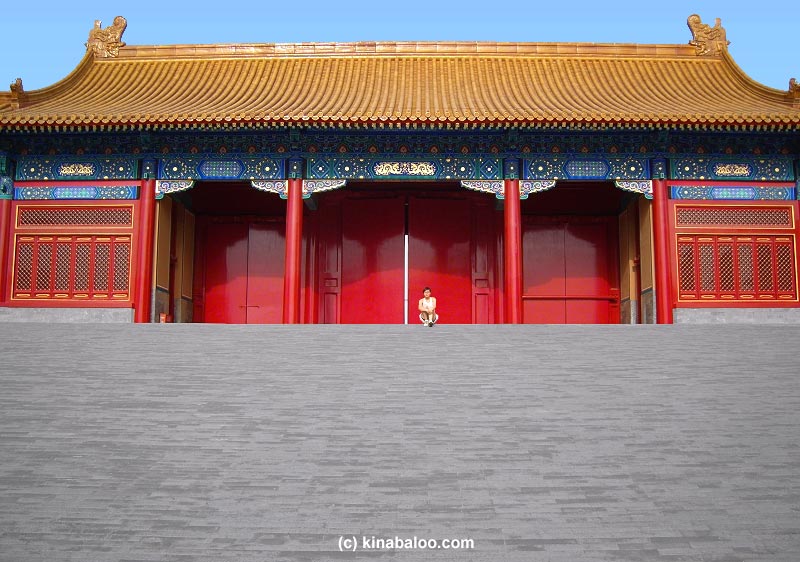
Source Here
© CrystalWind.ca 2024. All content (articles, imagery, fair use) & design protected. Written permission required for copying. All rights reserved.
Join the Conversation Now! Comment Below! ![]()

Spirit Animal Totem Of The Day!
Crystal Of The Day!
Latest Articles
CrystalWind.ca is free to use because of
donations from people like you.
Donate Now »

Unlock Your Light: Join Lightworkers Worldwide on CrystalWind.ca!
Articles: Atlantis
Articles: Crop Circles
Articles: Lemuria
Articles: Hollow Earth
Articles: Power Places
Articles: Sacred Places
Follow Us!
Who is Online Now
We have 23294 guests and no members online
Featured This Month
The Seven Chakras and their Meanings
If you could imagine chakras as circles of energy, flowing all the way throu... Read more
Frogs Return Moon
Beaver – Chrysocolla - Blue Camas – Blue April 20 – May 20 The Frogs Retur... Read more
Sun in Taurus
Sun in Taurus April 21 through May 21 An Overview of Sun Sign Characteristi... Read more
Taurus Mythology
The Taurus Myth The Taurus myth is most often interpreted as the story of Z... Read more
The Crystal Wind Oracle Card Deck
The Crystal Wind Oracle™ The Crystal Wind Oracle Myth & Magic Card D... Read more
The Time of No Time: Beltane!
Around the medicine wheel of life we go, from season to season (solstice to ... Read more
Cartomancy - Fortune Telling Using Playing C…
Cartomancy is the act of divining using cards. Divining means to find out by... Read more
Bright Beltane Blessings!
The wheel turns to Beltane, also known as Mayday, marking the beginning of S... Read more









































